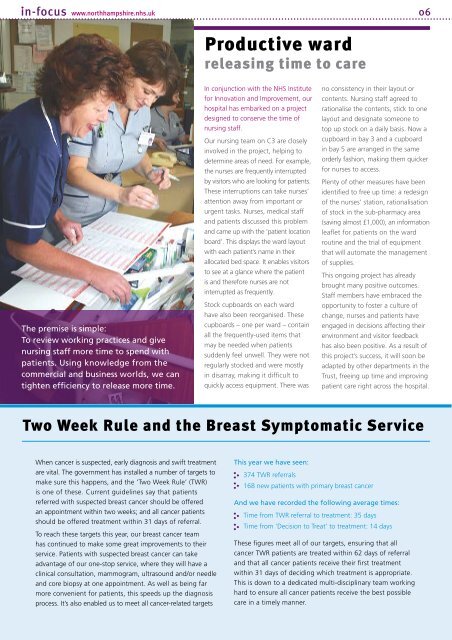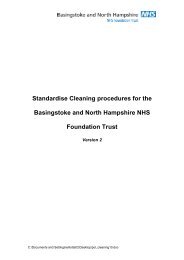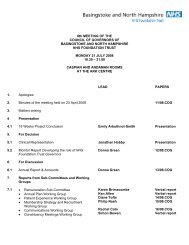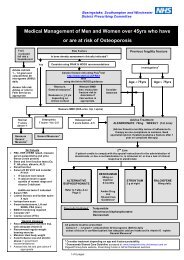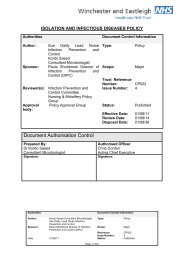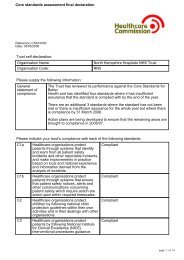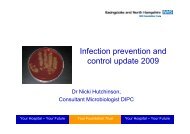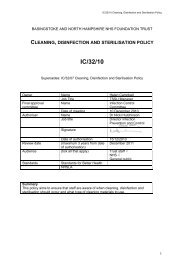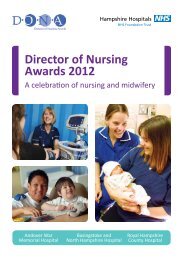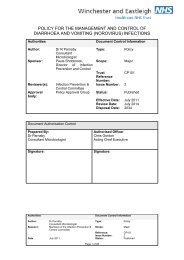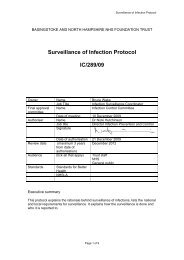InFocus Magazine 2007 - Hampshire Hospitals NHS Foundation Trust
InFocus Magazine 2007 - Hampshire Hospitals NHS Foundation Trust
InFocus Magazine 2007 - Hampshire Hospitals NHS Foundation Trust
Create successful ePaper yourself
Turn your PDF publications into a flip-book with our unique Google optimized e-Paper software.
06<br />
Productive ward<br />
releasing time to care<br />
The premise is simple:<br />
To review working practices and give<br />
nursing staff more time to spend with<br />
patients. Using knowledge from the<br />
commercial and business worlds, we can<br />
tighten efficiency to release more time.<br />
In conjunction with the <strong>NHS</strong> Institute<br />
for Innovation and Improvement, our<br />
hospital has embarked on a project<br />
designed to conserve the time of<br />
nursing staff.<br />
Our nursing team on C3 are closely<br />
involved in the project, helping to<br />
determine areas of need. For example,<br />
the nurses are frequently interrupted<br />
by visitors who are looking for patients.<br />
These interruptions can take nurses’<br />
attention away from important or<br />
urgent tasks. Nurses, medical staff<br />
and patients discussed this problem<br />
and came up with the ‘patient location<br />
board’. This displays the ward layout<br />
with each patient’s name in their<br />
allocated bed space. It enables visitors<br />
to see at a glance where the patient<br />
is and therefore nurses are not<br />
interrupted as frequently.<br />
Stock cupboards on each ward<br />
have also been reorganised. These<br />
cupboards – one per ward – contain<br />
all the frequently-used items that<br />
may be needed when patients<br />
suddenly feel unwell. They were not<br />
regularly stocked and were mostly<br />
in disarray, making it difficult to<br />
quickly access equipment. There was<br />
no consistency in their layout or<br />
contents. Nursing staff agreed to<br />
rationalise the contents, stick to one<br />
layout and designate someone to<br />
top up stock on a daily basis. Now a<br />
cupboard in bay 3 and a cupboard<br />
in bay 5 are arranged in the same<br />
orderly fashion, making them quicker<br />
for nurses to access.<br />
Plenty of other measures have been<br />
identified to free up time: a redesign<br />
of the nurses’ station, rationalisation<br />
of stock in the sub-pharmacy area<br />
(saving almost £1,000), an information<br />
leaflet for patients on the ward<br />
routine and the trial of equipment<br />
that will automate the management<br />
of supplies.<br />
This ongoing project has already<br />
brought many positive outcomes.<br />
Staff members have embraced the<br />
opportunity to foster a culture of<br />
change, nurses and patients have<br />
engaged in decisions affecting their<br />
environment and visitor feedback<br />
has also been positive. As a result of<br />
this project’s success, it will soon be<br />
adapted by other departments in the<br />
<strong>Trust</strong>, freeing up time and improving<br />
patient care right across the hospital.<br />
Two Week Rule and the Breast Symptomatic Service<br />
When cancer is suspected, early diagnosis and swift treatment<br />
are vital. The government has installed a number of targets to<br />
make sure this happens, and the ‘Two Week Rule’ (TWR)<br />
is one of these. Current guidelines say that patients<br />
referred with suspected breast cancer should be offered<br />
an appointment within two weeks; and all cancer patients<br />
should be offered treatment within 31 days of referral.<br />
To reach these targets this year, our breast cancer team<br />
has continued to make some great improvements to their<br />
service. Patients with suspected breast cancer can take<br />
advantage of our one-stop service, where they will have a<br />
clinical consultation, mammogram, ultrasound and/or needle<br />
and core biopsy at one appointment. As well as being far<br />
more convenient for patients, this speeds up the diagnosis<br />
process. It’s also enabled us to meet all cancer-related targets<br />
This year we have seen:<br />
374 TWR referrals<br />
168 new patients with primary breast cancer<br />
And we have recorded the following average times:<br />
Time from TWR referral to treatment: 35 days<br />
Time from ‘Decision to Treat’ to treatment: 14 days<br />
These figures meet all of our targets, ensuring that all<br />
cancer TWR patients are treated within 62 days of referral<br />
and that all cancer patients receive their first treatment<br />
within 31 days of deciding which treatment is appropriate.<br />
This is down to a dedicated multi-disciplinary team working<br />
hard to ensure all cancer patients receive the best possible<br />
care in a timely manner.


